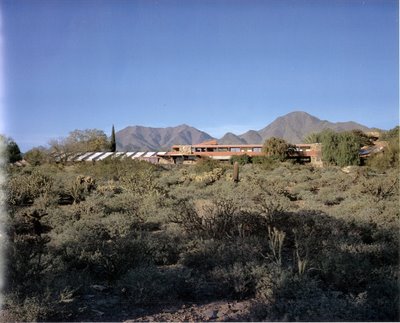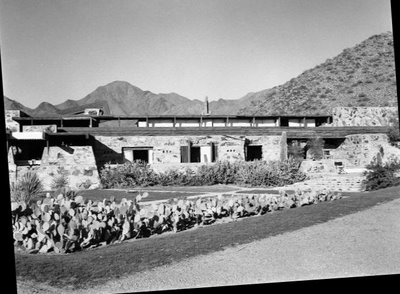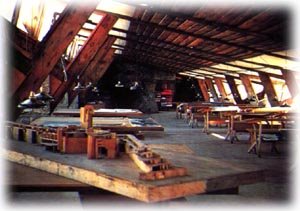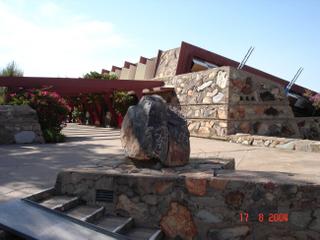 Extreme climates are an invitation to produce radical solutions in order to make a home for man in a place that offers no welcome. Frank Lloyd Wright maintained that the aim of architecture is to make nature more human, and human life more natural. Humanising nature when all it offers is the inhospitable is a triumph indeed. Tonight here on 'Not PC' our architecture debate continues with the third of PC's top five favourites: Frank Lloyd Wright's own home in the Arizona Desert, Taliesin West.
Extreme climates are an invitation to produce radical solutions in order to make a home for man in a place that offers no welcome. Frank Lloyd Wright maintained that the aim of architecture is to make nature more human, and human life more natural. Humanising nature when all it offers is the inhospitable is a triumph indeed. Tonight here on 'Not PC' our architecture debate continues with the third of PC's top five favourites: Frank Lloyd Wright's own home in the Arizona Desert, Taliesin West.



 In one of the most inhospitable habitats known to man, in the desert north of
In one of the most inhospitable habitats known to man, in the desert north of From the moment Wright saw it, he was attracted to the "vast battleground of titanic forces called Arizona." And, also, "the eternal and everlasting smile of the sun."
 Built when air-conditioning was available, but not yet popular, Wright intentionally eschewed it. He wanted the house to breathe, and he created an environment in which occupants and visitors could breathe free and savour what the architecture had made of this inhospitable location.
Built when air-conditioning was available, but not yet popular, Wright intentionally eschewed it. He wanted the house to breathe, and he created an environment in which occupants and visitors could breathe free and savour what the architecture had made of this inhospitable location.
As we walk through Frank Lloyd Wright’s own desert home, I'm reminded of Hamlet’s question: “What is a man? If the chief good and market of his time be but to sleep and feed? Away! A beast no more.”
 The building crouches lithely beneath the mountain range, its roof pitch, asymmetry, and construction somehow echoing the sheltering hills. The sharp features echo the small, sharp details of the desert plants.The big, strong, simple masses of ‘desert concrete’ fix the building to the landscape with material made of that same landscape.
The building crouches lithely beneath the mountain range, its roof pitch, asymmetry, and construction somehow echoing the sheltering hills. The sharp features echo the small, sharp details of the desert plants.The big, strong, simple masses of ‘desert concrete’ fix the building to the landscape with material made of that same landscape.
The building invites you in to gentle breezes, to the smell of citrus, to water-cooled air, to canvas roofs stretched over cypress roof beams with translucent yet gentle light filtered beautifully through the material.

 The visitor is invited into and through the building by the ingenuity of the architecture itself: from a distance it offers the visitor a ‘target,' and at each turning point as the visitor winds his way into the heart of the house another vista is offered up, and a choice offered: come this way or that. And at each node along the journey there is shade, and rest, and cool breezes, and a reappraisal of where one has been, and where one is going.
The visitor is invited into and through the building by the ingenuity of the architecture itself: from a distance it offers the visitor a ‘target,' and at each turning point as the visitor winds his way into the heart of the house another vista is offered up, and a choice offered: come this way or that. And at each node along the journey there is shade, and rest, and cool breezes, and a reappraisal of where one has been, and where one is going.
 This is human ingenuity in architecture at its very finest, and the very opposite of classical, centralised, symmetrical, forced architecture – instead this is relaxed, organic, ingenious human architecture that "makes nature more human and human life more natural."
This is human ingenuity in architecture at its very finest, and the very opposite of classical, centralised, symmetrical, forced architecture – instead this is relaxed, organic, ingenious human architecture that "makes nature more human and human life more natural."
In this place, Wright hasn’t just ‘made do.’Instead he’s celebrated what man can do in such a setting.
It is a masterpiece. One of the finest homes ever built.
RELATED: Architecture

1 comment:
PC - I'm swamped today so unfortunately I'll have to leave number 4 in the series until tomorrow lunchtime. Apologies for any disruption to the schedule.
DenMT
Post a Comment